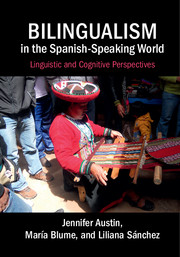1 - What does it mean to be bilingual?
Published online by Cambridge University Press: 05 May 2015
Summary
The bilingual is not two monolinguals in one person.
(Grosjean 1989: 1)Who is bilingual?
The hypothetical case histories – adapted from Hoffmann (1991) to the Spanish-speaking world – in Table 1.1 illustrate how different the bilingual experience can be.
For bilingual speakers, many of these stories will sound familiar, but for a monolingual speaker, the examples in Table 1.1 illustrate the heterogeneity of the experience of being bilingual. Case histories such as these can be categorized in four groups according to the speakers' reasons for becoming bilingual:
• Group A: children who are bilingual from birth or simultaneous bilinguals, either having two languages at home or one at home and one outside the home (playgroup, daycare, other family members).
• Group B: early bilinguals who start learning a second language sometime after birth, normally having one language at home and one outside home.
• Group C: people who learned a second language in adulthood who use it for work-related activities, in academia, as translators/interpreters, for reading specialized literature, or because they have jobs that require contact with several international colleagues.
• Group D: immigrants who must learn a second language to survive in the new country or speakers of a minority language in their own country who must learn the dominant language.
This grouping is just a simplification of all the possible variations of bilingualism in the world. Most of the cases we talk about in this book fall under type D, adults and children who are in a minority language situation either in their own country or because they immigrated. In two of our case studies, the Basque Country and Peru, Spanish is the majority language. In contrast, in the USA, Spanish is the minority language. In the Spanish-speaking world cases of bilinguals of types A through C can also be found.
Opinions as to who is a bilingual differ between monolingual people who have little contact with bilingualism and bilinguals themselves (and linguists).
- Type
- Chapter
- Information
- Bilingualism in the Spanish-Speaking WorldLinguistic and Cognitive Perspectives, pp. 39 - 86Publisher: Cambridge University PressPrint publication year: 2015



